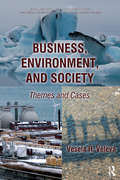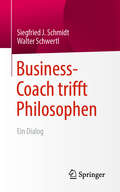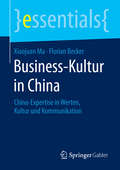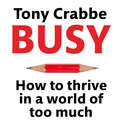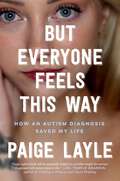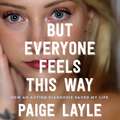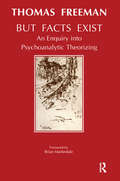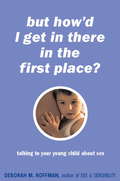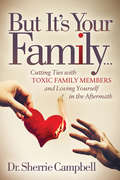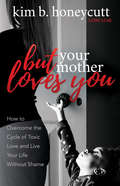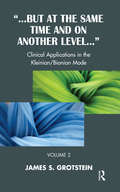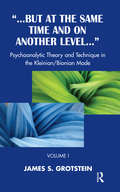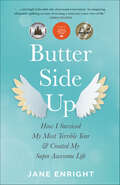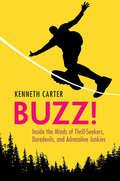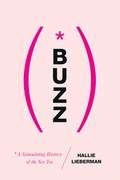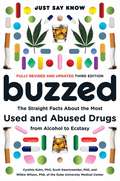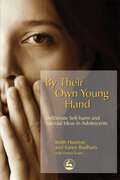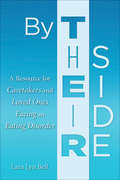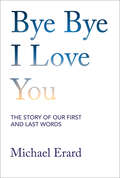- Table View
- List View
Business, Environment, and Society: Themes and Cases (Work, Health and Environment Series)
by Charles Levenstein John Wooding Vesela R. Veleva John ForrantThis book blends theory and practice to support courses in corporate social responsibility (CSR), business and society, and environmental management and sustainability. Based on her extensive work with companies, the author offers engaging readings and teaching cases that address key challenges for business today - measurement, supply chain management, public policy, and stakeholder pressures. Part I focuses on the macro-level and provides an overview of concepts such as the green economy, eco-industrial parks, corporate social responsibility (corporate citizenship), nanotechnology, and sustainable consumption. Part II provides specific frameworks and tools for sustainability management and measurement at the company level. Part III includes detailed teaching cases of several well-known firms. The main theme is that business is a key player in achieving a more sustainable development, yet its practices are often narrow in focus or shortsighted. The text provokes discussions around issues such as: Is business sustainability possible in a market economy focused on increasing consumption? Should a product or service be called "green" when it puts at risk the health and safety of workers? What can U.S. policymakers learn from their European counterparts when it comes to protecting human health and the environment? How can we ensure that the benefits of nanotechnology exceed its risks? How can sustainability indicators be used as a tool to advance sustainability by companies and policymakers? The book provides a flexible, up-to-date supplementary teaching tool for undergraduate and graduate students, executive education courses, and certificate programs. Intended Audience: Primarily undergraduate and graduate students taking courses in environmental management, corporate social responsibility (CSR), sustainability, or business and society; as a supplementary text in professional education and certificate programs in environmental management, corporate citizenship, sustainability, and CSR.
Business-Coach trifft Philosophen: Ein Dialog
by Walter Schwertl Siegfried J. SchmidtSJ Schmidt als bekannter Geisteswissenschaftler und Walter Schwertl Praktiker im Bereich Business-Coaching nähern sich in Dialogform der Frage, wie ein Geisteswissenschaftler und ein Praktiker eine hinreichend gemeinsame Konzeption von Kommunikation erarbeiten können. Gerade zwischen hoch abstrakten Theorien selbstreferentieller Systeme und dem, was als systemische Praxis bezeichnet wird, erscheint die Kluft unüberwindbar. Die Autoren spannen einen Bogen zwischen philosophischen Diskursen und Fragen alltäglichen Handelns. Der Hinweis auf die Vorgeschichte des Buches lässt erahnen, dass die Protagonisten Neugierde auf die Argumente des Anderen, Vertrauen und respektvollen Kommunikationsstil der Kluft erfolgreich entgegensetzen.
Business-Kultur in China: China-Expertise in Werten, Kultur und Kommunikation (essentials)
by Florian Becker Xiaojuan MaDas chinesisch-deutsche Autorenteam Prof. Dr. Xiaojuan Ma und Prof. Dr. Florian Becker liefert prägnant die wichtigsten Wissensbausteine und Tipps zur Business-Kultur in China. Sie garantieren mit langjähriger Praxiserfahrung, wissenschaftlicher Basis und Heimat in beiden Kulturen wertvolles Insider-Wissen. Die Leser erhalten hier eine kulturelle Sensibilisierung aus erster Hand für den Erfolg im chinesischen Business-Kontext.
Buster
by Caleb HuettBuster's a therapy dog who needs to take matters into his own paws to help a boy understand his own anxiety even if it means breaking a few rules.Buster's in big trouble. He's been dragged to Dog Court for breaking one of the most sacred of all dog rules: Never, ever talk to a human, or let a human know how smart you really are.But he swears he had a good reason! The boy he's been taking care of, Tonio, needed his help in a big way. You see, Tonio is afraid all the time -- afraid of saying or doing the wrong thing, afraid of making a fool of himself or (even worse) hurting someone else's feelings. His doctor thinks having a therapy dog will help his anxiety -- and Buster wants to help. He really wants to help. Even if it means breaking the rules
Busy: How to Thrive in A World of Too Much
by Tony Crabbe'Life-changing' Daily ExpressIf you want to take control of your career - and your life - make sure you're not too busy to read this book.Today's world is one of too much: too much work to do, too much communication, too much competition, too much uncertainty and too much information. We are striving to keep up, but inevitably we're falling behind, leaving us with a nagging sense of failure that is hard to shake off. In Busy, Tony Crabbe debunks the myth that satisfaction at work comes from getting everything done.Instead, he demonstrates that what will enable you to thrive is regaining a sense of mastery over your life, focusing on making an impact, engaging with loved ones and creating the momentum necessary to make changes.'You'll want to ban "busy" from your vocabulary after reading this delightful takedown of busyness as an excuse . . . a very smart, fun and enlightening read' Success Magazine
Busy: How to Thrive in A World of Too Much
by Tony CrabbeIt's difficult to ask anybody 'How are you?' without hearing the word 'busy' somewhere in their response. We feel overwhelmed by busyness because of the demands on our time: our inbox and our to-do list are bulging, a huge amount of people expect things from us and our organisations are trying to do more with fewer people. But it doesn't have to be that way. In reality, busyness isn't essential. Yes, there is a lot to do, but believing you're always busy because you have so much to do is both false and unhelpful. Busyness is a normal response to a world of too much, but it isn't the only response.In Busy Tony Crabbe draws on solid psychological research to address one of the great problems of modern life: we're too busy. But it isn't a time-management book. Rather than providing advice for increasing productivity and efficiency, it sets out four key strategies (corresponding to sections of the book) for thriving despite of the overload of too much:1. Mastery - to move beyond busyness you need to regain a sense of mastery over your life. This section shows you how to build a sense of control back into your life, take responsibility for making choices and how to set boundaries to protect you from the flood of demands and information.2. Focus - in a world of too much, success is not about doing more at work but about making an impact. This section outlines three ways to move to a career strategy that doesn't rely on productivity alone.3. Engagement - busyness can cause you to disengage from the people, values and activities that are important to us. This section provides you with the three keys to re-engaging with your work and life.4. Momentum - part of the challenge to moving beyond busyness is that even if you agree you should make the change, you're too busy to find the time and energy to do anything about it. This section is dedicated to helping you make the change, creating the impetus, energy and clarity to move to a life less busy.
But Everyone Feels This Way: How an Autism Diagnosis Saved My Life
by Paige LayleAutism acceptance activist and TikTok influencer Paige Layle shares her deeply personal journey to diagnosis and living life autistically. &“For far too long, I was told I was just like everyone else. But knew it couldn&’t be true. Living just seemed so much harder for me. This wasn&’t okay. This wasn&’t normal. This wasn&’t functioning. And it certainly wasn&’t fine.&” Paige Layle was normal. She lived in the countryside with her mom, dad, and brother Graham. She went to school, hung out with friends, and all the while everything seemed so much harder than it needed to be. A break in routine threw off the whole day. If her teacher couldn't answer &“why&” in class, she dissolved into tears, unable to articulate her own confusion or explain her lack of control. But Paige was normal. She smiled in photos, picked her feet up when her mom needed to vacuum instead of fleeing the room, and earned high grades. She had friends and loved to perform in local theater productions. It wasn&’t until a psychiatrist said she wasn&’t doing okay, that anyone believed her. In But Everyone Feels This Way, Paige Layle shares her story as an autistic woman diagnosed late. Armed with the phrase &“Autism Spectrum Disorder&” (ASD), Paige challenges stigmas, taboos, and stereotypes while learning how to live her authentic, autistic life.
But Everyone Feels This Way: How an Autism Diagnosis Saved My Life
by Paige LayleIn But Everyone Feels This Way, Autism acceptance activist and multi-million-follower TikTok influencer Paige Layle shares her deeply personal journey to diagnosis and living life autistically. It all started out pretty normal: Paige lived in the countryside with her parents and brother Graham. She went to school, hung out with friends, and all the while everything seemed so much harder than it needed to be. A break in routine threw off the whole day. If her teacher couldn't answer 'why?' in class, she dissolved into tears, unable to articulate her own confusion or explain her lack of control. But Paige was normal. She smiled in photos, picked her feet up when her mum needed to vacuum instead of fleeing the room, and did well at school. She was popular and well-liked. And until she had a full mental breakdown, no one believed her when she claimed that she was not okay.Women are frequently diagnosed with autism much later than men, often in their late teens or early twenties. Armed with her new diagnosis, Paige set out to learn how to live her authentic, autistic life, and discovered how autism could be a source of strength. She challenges stigmas, taboos, and stereotypes so that everyone can see themselves authentically. Along the way, her online activism has spread awareness, acceptance, and self-recognition in millions of others.
But Everyone Feels This Way: How an Autism Diagnosis Saved My Life
by Paige LayleIn But Everyone Feels This Way, Autism acceptance activist and multi-million-follower TikTok influencer Paige Layle shares her deeply personal journey to diagnosis and living life autistically. It all started out pretty normal: Paige lived in the countryside with her parents and brother Graham. She went to school, hung out with friends, and all the while everything seemed so much harder than it needed to be. A break in routine threw off the whole day. If her teacher couldn't answer 'why?' in class, she dissolved into tears, unable to articulate her own confusion or explain her lack of control. But Paige was normal. She smiled in photos, picked her feet up when her mum needed to vacuum instead of fleeing the room, and did well at school. She was popular and well-liked. And until she had a full mental breakdown, no one believed her when she claimed that she was not okay.Women are frequently diagnosed with autism much later than men, often in their late teens or early twenties. Armed with her new diagnosis, Paige set out to learn how to live her authentic, autistic life, and discovered how autism could be a source of strength. She challenges stigmas, taboos, and stereotypes so that everyone can see themselves authentically. Along the way, her online activism has spread awareness, acceptance, and self-recognition in millions of others.
But Facts Exist: An Enquiry into Psychoanalytic Theorizing
by Thomas FreemanThis book provides an account of the chequered course of international psychoanalysis over the last 100 years, with a lucid critical treatment of the major theoretical developments, illustrated by clinical examples drawn from the author's own vast experience.
But How'd I Get In There In The First Place?: Talking To Your Young Child About Sex
by Deborah RoffmanFor parents of three to six year olds, a wise and charming guide to talking about sex, conception, and birth
But It’s Your Family . . .: Cutting Ties with Toxic Family Members and Loving Yourself in the Aftermath
by Dr. Sherrie CampbellA psychologist offers a roadmap for those looking to break free of toxic family relationships and thrive in the aftermath.Toxic family abuse is always two-fold. The first layer of abuse is the original poor treatment by toxic family members, and the second is someone&’s denial of the ways in which abusers treat and harm them. Loving someone doesn&’t always mean having a relationship with them, just like forgiveness doesn&’t always mean reconciliation. A significant part of healing comes with accepting that there are some relationships that are so poisonous that they destroy one&’s ability to be healthy and function best. But It&’s Your Family is a remarkable account of what it means to cut ties to toxic family abuse and thrive in the aftermath.Inside, Dr. Sherrie Campbell clarifies:· How parents, adult children, siblings, grandparents, and in-laws can be toxic· The difference between flawed and toxic family members· Explaining the cutting of ties to children and others who may not understand· Spiritual and religious views on forgiveness· The definition of cutting ties and what No Contact actually means When readers are able to bring closure to those toxic relationships, they give themselves the space to love those family members from a distance, as fellow human beings, with the knowledge that it is unwise to remain connected. Readers learn how to love themselves in the process and fundamentally change their lives for the better!
But You're Still So Young: How Thirtysomethings Are Redefining Adulthood
by Kayleen SchaeferOne of…VOGUE's &“Best of 2021&” — BuzzFeed's &“Most Anticipated 2021&” — The Week's &“Must Reads in 2021&”From the author of Text Me When You Get Home, a look at what it means to be in your thirties, and to navigate some of the biggest milestones of adult life . . . and how it is more okay than ever to not have every box checked off On Kayleen Schaefer&’s birthday she went dancing with friends, they broke a table, and she turned thirty standing on the sidewalk outside a club she got kicked out of. Sociologists have identified the five markers of adulthood as: finishing school, leaving home, marriage, gaining financial independence, and having kids. But the signifiers of being in our thirties today are not the same—repeated economic upheaval, rising debt, decreasing marriage rates, fertility treatments, and a more open-minded society have all led to a shifting timeline. Americans are taking major life steps later, switching careers with unprecedented frequency, and exercising increased freedom and creativity in their decisions about how to shape their lives. So why are we measuring "adulthood" by the same metrics that were relied upon fifty years ago? BUT YOU'RE STILL SO YOUNG is cleverly structured around these five major life events. For each milestone, the book highlights men and women from various backgrounds, from around the country, and delves into their experiences navigating an ever-changing financial landscape and evolving societal expectations. The eight thirtysomethings in this book envisioned their thirties differently than how they are actually living them. He thought he would be done with his degree, she thought she&’d be married, they thought they&’d be famous comedians, and everyone thought they would have more money. Kayleen uses her smart narrative framing, her relatable voice, and her own story to show how the thirties have changed from the cultural stereotypes around them, and how they are a radically different experience for Americans now than it was for any other generation. And as she and her sources show, not being able to do everything isn&’t a sign of a life gone wrong. Being open to going sideways or upside down or backward, means it has gone right: you found meaning and value in many different ways of living.
But Your Mother Loves You: How to Overcome the Cycle of Toxic Love and Live Your Life Without Shame
by Kim B. HoneycuttBut Your Mother Loves You is the witty and candid tale of how a renowned psychotherapist moved from “not good enough” to “the right person” despite childhood neglect and a toxic relationship with her mother. Everyone knows at least one person who demonstrates toxic love, someone who consistently jabs a straw in others and sucks the life right out of them. Without an in-depth understanding of how to navigate these relationships, most people continue to emotionally regress and remain paralyzed in familiar, pain-soaked patterns. But Your Mother Loves You helps readers overcome this cycle of toxicity. Kim Honeycutt shares the real-life experience of how a shame-based, self-destructive little girl grew up to be a recovered alcoholic, entered the world of psychology as a professional, and created her own strategies to address and conquer toxicity. This story, both witty and practical, is told through the lens of personal life experience and expert psychological strategies combined with Godly intervention. Readers learn how to either walk away from or walk with a toxic loved one without losing themselves. Covered in both vulnerability and clinical information, But Your Mother Loves You provides a step-by-step approach on how to stop toxic love and the subsequent self-abuse.
But at the Same Time and on Another Level: Clinical Applications in the Kleinian/Bionian Mode
by James S. GrotsteinThis book discusses general principles on how the psychoanalyst or psychoanalytically informed psychotherapist may optimally provide and maintain the setting for the psychoanalysis. It also discusses the foundational work of Klein's original contributions.
But at the Same Time and on Another Level: Psychoanalytic Theory and Technique in the Kleinian/Bionian Mode
by James S. GrotsteinThis book is organized as a handbook, a "beginning", to elucidate general principles on how the psychoanalyst or psychoanalytically informed psychotherapist may optimally provide and maintain the setting for the psychoanalysis, and ultimately intervene with interpretations.
But for the Grace of God
by Peter G. CranfordA scholarly yet absorbing history of one of the best, worst, and largest insane asylums in the world.
Butter Side Up: How I Survived My Most Terrible Year & Created My Super Awesome Life
by Jane Enright“A world changing book on health and wellness for this millennium.” —Living Now Book AwardsSometimes, in the blink of an eye, the unthinkable can happen; events in your life that cause you to ask Why me?Inspired and inspiring, award-winning author Jane Enright’s extraordinary, uplifting memoir captures her journey as she survives three life-altering events in the span of a year, losing almost everything, and comes out the other side stronger, more resilient, and happier than ever before. Compelling and thought provoking, Butter Side Up is not only a feel-good story that everyone can relate to and learn from, but also proof there can be happiness and joy after the unexpected—and a super awesome life, too.
Buzz!: Inside the Minds of Thrill-Seekers, Daredevils, and Adrenaline Junkies
by Kenneth CarterMost of us crave new experiences and sensations. Whether it's our attraction to that new burger place or the latest gadget, newness tugs at us. But what about those who can't seem to get enough? They jump out of planes, climb skyscrapers, and will eat anything (even poisonous pufferfish) … Prompting others to ask 'what's wrong' with them. These are high sensation-seekers and they crave intense experiences, despite physical, or social risk. They don't have a death wish, but seemingly a need for an adrenaline rush, no matter what. Buzz! describes the world of the high sensation-seeking personality in a way that we can all understand. It explores the lifestyle, psychology, and neuroscience behind adrenaline junkies and daredevils. This tendency, or compulsion, has a role in our culture. But where is the line between healthy and unhealthy thrill-seeking? The minds of these adventurers are explained page by page.
Buzz: The Stimulating History Of The Sex Toy
by Hallie LiebermanIn the vein of Mary Roach's Bonk, a brilliant microhistory of the sex toy that ultimately tells the story of our changing sexual mores and evolving cultural values. Once only whispered about in clandestine corners, vibrators have become just another accessory for the suburban soccer mom. But how did these once-taboo toys become so socially acceptable? The journey of the devices to the cultural mainstream is a surprisingly stimulating one. In Buzz, Hallie Lieberman provides a riveting history that tells the story of sex toys from ancient phalluses to 21st century vibrating rabbits. She focuses on the period from the 1950s through the present, when sex toys evolved from symbols of female emancipation to tools in the fight against HIV/AIDS to consumerist marital aids and finally to mainstays of today's pop culture. Lieberman's history is populated by vivid and fascinating characters, including Ted Marche, an entrepreneurial ventriloquist and dildo maker; Duane Coleglazier, the gay ice cream truck driver who founded the first boutique sex-toy store; Dell Williams, ex-communist advertising maven who created the feminist sex toy store; Betty Dodson, whose workshops helped 1960s women discover vibrators; and Gosnell Duncan, a paraplegic engineer who invented the silicone dildo. And these personal dramas are all set against a backdrop of changing American attitudes toward sexuality, feminism, LGBTQ issues, and more. Both educational and titillating, Buzz will make readers think quite differently about those secret items hiding in bedside drawers across the nation.
Buzzed: The Straight Facts About The Most Used And Abused Drugs From Alcohol To Ecstasy
by Cynthia Kuhn Scott Swartzwelder Wilkie WilsonThe third edition of the essential, accessible source for understanding how drugs work and their effects on body and behavior. Together, the first two editions of Buzzed have sold over 120,000 copies-and now the authors have revised and updated the book to include the most recent discoveries about drugs, including new information on the energy drinks craze, prescription drugs such as OxyContin and Ambien, and the date-rape drug GHB. Scientifically accurate and easy to read, this no-nonsense handbook gives the most balanced, objective information available on the most often used and abused drugs, from alcohol, caffeine, and nicotine to heroin, Ecstasy, and methamphetamine. In both quick-reference summaries and in-depth analysis, it reports on how these drugs enter the body, how they manipulate the brain, their short-term and long-term effects, the kinds of "high" they produce, and the circumstances in which they can be deadly. Neither a "Just Say No" treatise nor a "How to" manual, Buzzed is based on the conviction that people make better decisions with accurate information at hand.
By Their Own Young Hand: Deliberate Self-harm and Suicidal Ideas in Adolescents
by Karen Rodham Keith Hawton Emma EvansSelf-harm in adolescents is an increasingly recognized problem, and there is growing awareness of the important role schools and health services can play in detecting and supporting those at risk. By Their Own Young Hand explores the findings of the first large-scale survey of deliberate self-harm and suicidal thinking in adolescents in the UK, and draws out the implications for prevention strategies and mental health promotion. Six thousand young people were asked about their experiences of self-harm, the coping methods they use, and their attitudes to the help and support available. The authors identify the risk and protective factors for self-harm, exploring why some adolescents with suicidal thoughts go on to harm themselves while others do not, what motivates some young people to seek help, and whether distressed teenagers feel they receive the support they need. By Their Own Young Hand offers practical advice on how schools can detect young people at risk, cope with the aftermath of self-harm or attempted suicide, and develop training programmes for teachers. It also examines the roles of self-help, telephone helplines, email counselling, and walk-in crisis centres. Packed with adolescents' own personal accounts and perspectives, this accessible overview will be essential reading for teachers, social workers and mental health professionals.
By Their Side: A Resource for Caretakers and Loved Ones Facing an Eating Disorder
by Lara Lyn BellThis practical resource guide shares essential information and personal stories from eating disorder survivors, family members, caretakers, and others.When someone you love is in the throes of an eating disorder, it can be difficult to believe recovery is possible. By Their Side offers help and hope to those fighting alongside a loved one in the struggle against this heartbreaking illness. Providing first-hand testimony, scientific expertise, resources, and actionable guidance, the book serves as a lifeline for both the individual coping with the disease and those struggling to give them the right support.Written collectively under the name Lara Lyn Bell, By Their Side draws together the diverse stories of families, friends, doctors, therapists, caregivers, and recovered eating disorder advocates. The Lara Lyn Bell collective speaks together to emphasize the insidious, cross-cultural impact of this life-or-death issue. As a result of their united anonymity, By Their Side mirrors the reader’s story as they connect with the shared challenges, successes, and perspectives on their journey to healing.
By the Time You Read This: The Space between Cheslie's Smile and Mental Illness—Her Story in Her Own Words
by April Simpkins Cheslie KrystBy the Time You Read This is the story former Miss USA Cheslie Kryst was about to publish before her tragic suicide. Her mother, April, wraps up the narrative by exploring the mental illness and depression that took her daughter&’s life.The text read, &“By the time you get this . . .&” This is the story of Cheslie Kryst, a former Miss USA, in her own words. When the world awoke on the morning of January 30, 2022, many were shocked to learn of the tragic death of former Miss USA Cheslie Kryst. For most people, the news was unfathomable. How could a young woman in the prime of her life—a pageant queen, accomplished attorney, Extra correspondent, and tireless advocate for charity organizations—have been lost to the world so suddenly? By the Time You Read This shares the manuscript Cheslie wrote before her passing, her story in her own words—from the highest highs of passing two bar exams, winning Miss USA, and beginning an exciting career as an entertainment journalist to the lowest lows of heartbreak, betrayal, and persistent depression. When Cheslie&’s mother, April Simpkins, picks up the narrative, she shares for the first time what she experienced in the aftermath of Cheslie&’s suicide. When faced with such a devastating loss, how does a mother find a way to carry on? Whether you are someone who struggles to maintain your mental health, or you love someone who does, this book will share insight into a reality that impacts thousands of families every year—as well as provide hope for those who are left behind. Net proceeds from the book will be used to support the Cheslie C. Kryst Foundation, which is being founded in Cheslie&’s honor.
Bye Bye I Love You: The Story of Our First and Last Words
by Michael ErardA beautiful and intimate exploration of first and last words—and the many facets of how language begins and ends—from a pioneering language writer.With our earliest utterances, we announce ourselves—and are recognized—as persons ready for social life. With our final ones, we mark where others must release us to death&’s embrace. In Bye Bye I Love You, linguist and author Michael Erard explores these phenomena, commonly called &“first words&” and &“last words,&” uncovering their cultural, historical, and biological entanglements and honoring their deep private significance. Erard draws from personal, historical, and anthropological sources to provide a sense of the breadth of beliefs and practices about these phenomena across eras, religions, and cultures around the world.What do babies&’ first words have in common? How do people really communicate at the end of life? In the first half of the book, Erard tells the story of first words in human development and evolution, and how the attention to children&’s early language—a modern phenomenon—arose. In the second half, he provides a groundbreaking overview of language at the end of life and the cultural conventions that surround it. Throughout he reveals the many parallels and asymmetries between first and last words and asks whether we might be able to use a linguistic understanding of end of life to discover what we truly want.
